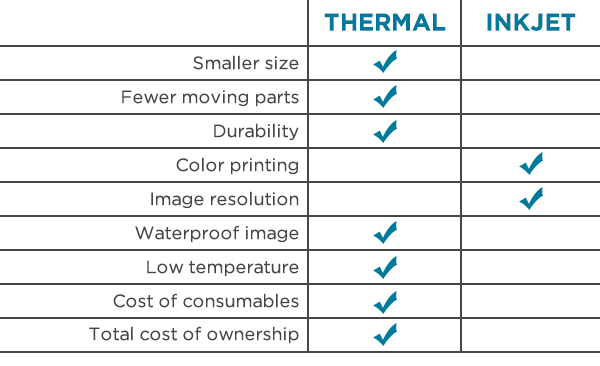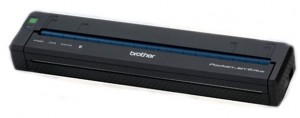Which type of printer works best for vehicle-based Law Enforcement purposes?
Let me begin my answer with a story.
A few years ago, on a hot and muggy summer day, a driver rear-ended my wife’s car. Luckily, no one was injured. The Deputy Sheriff gave my wife a copy of the accident report that he printed with the inkjet printer in his car. When she got home she could not read it. The report had touched the cold drink in the cup holder that had sweat due to the humidity. This caused the ink on the paper to run, rendering the report partially unreadable. The good news is that the Deputy had used an electronic accident reporting application, and it was easy for someone in the office to print another copy of the report.
Printers Simplified: Inkjet Vs Thermal
Most printers used in patrol vehicles are either:
- Inkjet – Small nozzles spray liquid ink onto paper
- Direct Thermal – Small pins heat a coating on the paper
Let’s take a closer look at the pros and cons of each of these printing technologies to see how each measures up in the following categories.
Durability & Life Span
Most direct thermal printers have a print head that is the entire width of the paper, allowing the print head to remain stationary while it prints. An inkjet printer prints from a small ink cartridge, requiring the printer to move the ink cartridge back and forth while it prints. This means there are fewer moving parts in a direct thermal printer and therefore a simpler design than inkjet printers. This simplicity makes them less expensive to build, which lowers their purchase price. Fewer moving parts also makes them more durable and long-lasting. This leads to a lower total cost of ownership. The simpler design of a direct thermal printer further allows for a more compact design, saving precious space in already cramped patrol cars. Is it just me or do patrol cars seem to shrink with each new model that comes out?
Cost of Consumables
The heat-sensitive coating required on the paper of a direct thermal printer results in more expensive paper than the standard office paper you can use in an inkjet printer. However, the money saved on paper for an inkjet printer is offset because inkjet printers also require ink cartridge replacement, which direct thermal printers do not need.
Most inkjet printers only allow printing on single sheets of paper. There is no way to secure the paper in an inkjet printer, so for safety you should load and unload the paper with every use. Some direct thermal printers allow printing on rolls of paper, where the paper is held in place securely even between print jobs. Not having to constantly load and unload paper makes a direct thermal printer easier and safer to use.
Image Quality
Because thermal paper reacts to heat, it is possible that the heat in a vehicle can cause thermal paper to darken, especially in areas where the outside temperature gets very hot. This is typically not an issue with higher quality paper that has an archivability rating. Heat can also cause gradual fading of the direct thermal image but this would take longer than the lifespan of the average ticket. Inkjet printers can produce higher resolution images and allow color printing that makes them better suited to printing images and pictures. In areas where the outside temperature gets well below freezing, an inkjet printer may produce a poor or unreadable image if the ink gets too cold. Thinking back to the story of my wife’s car accident, the original accident report she was given would have been fine had it been printed with a direct thermal printer.
The Better Choice is…
In my opinion, direct thermal printers are the way to go. Although there are pros and cons of each type of printer, the advantages of a direct thermal printer outweigh the negatives.

PocketJet® 6 Plus Thermal Printer with Bluetooth
The most popular direct thermal printer for Law Enforcement is the PocketJet® Printer made by Brother Mobile Solutions. If you are in the process of implementing an eCitation and Accident Reporting system or you currently use inkjet printers and would like to try a PocketJet® printer, contact us at L-Tron for more information or a demo.
About the Author:
 Charlie has a broad background in industrial solutions and systems within the government and manufacturing sectors. His experience in software development, control systems and project management along with his background in engineering, sales and training has given him a solid understanding of customers needs’ and has established a loyal following. Charlie can be reached at 800.830.9523 x111; charlie.waldman@L-Tron.com
Charlie has a broad background in industrial solutions and systems within the government and manufacturing sectors. His experience in software development, control systems and project management along with his background in engineering, sales and training has given him a solid understanding of customers needs’ and has established a loyal following. Charlie can be reached at 800.830.9523 x111; charlie.waldman@L-Tron.com













